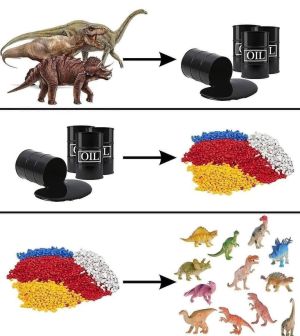Plastic
Plastic: The Ubiquitous Petroleum-Based Conundrum
Introduction: How Plastic Took Over the World
Plastic is everywhere. It’s in your packaging, your car, your clothes, and even (tragically) your oceans. Derived largely from petroleum, this versatile material rose to prominence in the 20th century as a marvel of modern science. Lightweight, durable, and cheap to produce, plastic revolutionized industries from medicine to manufacturing, making our lives more convenient and, in the process, entrenching itself into every corner of modern civilization.
But beneath its shiny, disposable appeal lies a tangled web of environmental devastation, corporate propaganda, and economic exploitation. Plastic, once hailed as the material of the future, has become an ecological nightmare.
The False Promise of Recycling
When you toss that water bottle into the recycling bin, you likely feel a pang of eco-virtue. But the uncomfortable truth is that most plastics are not recyclable, or at least not economically viable to recycle.
The recycling symbol, that ubiquitous triangle chasing itself on the bottom of nearly every plastic product, is more marketing than a guarantee of sustainability. Only a handful of plastics—specifically PET (#1) and HDPE (#2)—are regularly recycled, and even then, they degrade in quality after each cycle, meaning they’ll eventually be discarded anyway.
Here’s why recycling isn’t the miracle solution we’ve been sold:
- Sorting Complexity: Plastics come in various types, each with different melting points and chemical properties. Sorting them is expensive and prone to contamination.
- Downcycling: Recycled plastic often becomes a lower-grade material that isn’t suitable for the same applications as the original product.
- Economic Unviability: Virgin plastic, made directly from petroleum, is almost always cheaper than recycled plastic, making recycling unappealing for manufacturers.
Despite widespread public belief in recycling as a solution, less than 10% of all plastic ever produced has been successfully recycled.
The Big Oil Smoke and Mirrors
Let’s talk about the culprits: Big Oil. Companies like ExxonMobil, Chevron, and Shell have a vested interest in ensuring plastic remains a cornerstone of global commerce. Here’s the kicker: as the world shifts to renewable energy, these corporations need new revenue streams. Enter plastic, which uses fossil fuels for its creation and perpetuates dependence on petroleum.
In the 1970s and 1980s, when environmental concerns about plastic pollution began surfacing, the industry scrambled to defend its reputation. The solution? Massive marketing campaigns promoting recycling. These efforts shifted the burden of responsibility to consumers, diverting attention away from the systemic problem of overproduction.
A prime example is the Keep America Beautiful campaign, funded by industry groups, which guilt-tripped individuals into believing that littering—not corporate overproduction—was the problem. Meanwhile, companies ramped up plastic production, reaping billions as the public chased an illusion of sustainability.
Landfills, Not Loops: Where Plastic Actually Goes
While the idea of a "circular economy" is enticing, the reality is grim: most plastic waste ends up in landfills or the environment. When recycling fails (which it often does), these durable, non-biodegradable materials sit in dumps for centuries, leaching toxins into the soil and water. Even worse, some "recycled" plastics are exported to countries with less stringent environmental regulations, where they’re incinerated, creating another layer of pollution.
ESG: The Greenwashing Buzzword
Environmental, Social, and Governance (ESG) initiatives have gained traction as corporations seek to project an image of responsibility. While some ESG efforts are genuine, many are little more than greenwashing.
Consider the plastic industry’s ESG efforts: companies tout biodegradable plastics or investments in recycling technology as proof of their commitment to sustainability. Yet these initiatives often account for a minuscule fraction of their overall operations, serving more as PR than substantive change.
In truth, the ESG framework is often wielded to distract consumers and investors from the root issue: the overproduction of plastic. The only real solution lies in reducing reliance on single-use plastics altogether, a move that would directly threaten industry profits.
What Needs to Change
- Legislation Over Voluntary Measures: Governments should enforce bans on single-use plastics and tax virgin plastic production to incentivize alternatives.
- Corporate Accountability: Big Oil and plastic manufacturers must be held responsible for the lifecycle of their products. Extended producer responsibility (EPR) laws can help.
- Consumer Awareness: While individual action isn’t the solution, public pressure can drive systemic change. Refusing unnecessary plastic products and advocating for policy shifts are key.
- Innovative Materials: Research into sustainable alternatives like bioplastics or reusable materials must be prioritized and funded.
Conclusion: The Plastic Reckoning
Plastic has indeed taken over the world, but its reign comes at a heavy cost. The promises of recycling and ESG initiatives, while appealing on the surface, are largely distractions perpetuated by an industry bent on maximizing profits. True progress requires confronting the uncomfortable reality that the problem is not just our waste habits but the very existence of cheap, disposable plastics.
To move forward, we need a societal shift away from convenience at all costs and toward a future where durability, reusability, and sustainability take precedence over Big Oil’s profit margins. Until then, the plastic crisis will remain a stain on our planet, hiding in plain sight.
